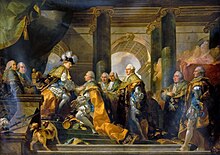
Marie Antoinette was the last queen of France prior to the French Revolution. She was born an archduchess of Austria, and was the penultimate child and youngest daughter of Empress Maria Theresa and Emperor Francis I. She became dauphine of France in May 1770 at age 14 upon her marriage to Louis-Auguste, heir apparent to the French throne. On 10 May 1774, her husband ascended the throne as Louis XVI and she became queen.

Louis XVI was the last king of France before the fall of the monarchy during the French Revolution.

The Palace of Versailles is a former royal residence commissioned by King Louis XIV located in Versailles, about 19 kilometers (12 mi) west of Paris, France.

Louis XV, known as Louis the Beloved, was King of France from 1 September 1715 until his death in 1774. He succeeded his great-grandfather Louis XIV at the age of five. Until he reached maturity in 1723, the kingdom was ruled by his grand-uncle Philippe II, Duke of Orléans, as Regent of France. Cardinal Fleury was chief minister from 1726 until his death in 1743, at which time the king took sole control of the kingdom.

Louis XVIII, known as the Desired, was King of France from 1814 to 1824, except for a brief interruption during the Hundred Days in 1815. He spent 23 years in exile from 1791: during the French Revolution and the First French Empire (1804–1814), and during the Hundred Days.
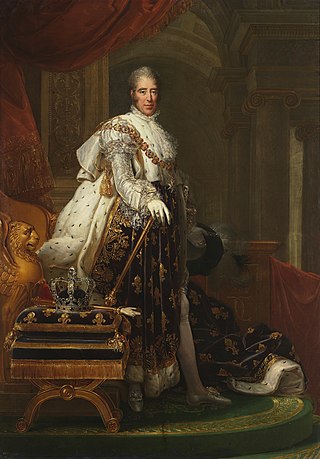
Charles X was King of France from 16 September 1824 until 2 August 1830. An uncle of the uncrowned Louis XVII and younger brother of reigning kings Louis XVI and Louis XVIII, he supported the latter in exile. After the Bourbon Restoration in 1814, Charles became the leader of the ultra-royalists, a radical monarchist faction within the French court that affirmed absolute monarchy by divine right and opposed the constitutional monarchy concessions towards liberals and the guarantees of civil liberties granted by the Charter of 1814. Charles gained influence within the French court after the assassination of his son Charles Ferdinand, Duke of Berry, in 1820 and succeeded his brother Louis XVIII in 1824.
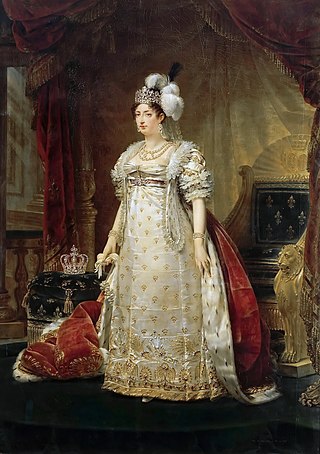
Marie-Thérèse Charlotte was the eldest child of King Louis XVI and Queen Marie Antoinette of France, and their only child to reach adulthood. In 1799 she married her cousin Louis Antoine, Duke of Angoulême, the eldest son of Charles, Count of Artois, henceforth becoming the Duchess of Angoulême. She was briefly Queen of France in 1830.

The French Crown Jewels and Regalia comprise the crowns, orb, sceptres, diadems and jewels that were symbols of Royal or Imperial power between 752 and 1870. These were worn by many Kings and Queens of France as well as Emperor Napoleon. The set was finally broken up, with most of it sold off in 1885 by the Third Republic. The surviving French Crown Jewels, principally a set of historic crowns, diadems and parures, are mainly on display in the Galerie d'Apollon of the Louvre, France's premier museum and former royal palace, together with the Regent Diamond, the Sancy Diamond and the 105-carat (21.0 g) Côte-de-Bretagne red spinel, carved into the form of a dragon. In addition, some gemstones and jewels are on display in the Treasury vault of the Mineralogy gallery in the National Museum of Natural History.

Louis Antoine of France, Duke of Angoulême was the elder son of Charles X and the last Dauphin of France from 1824 to 1830. He is identified by the Guinness World Records as the shortest-reigning monarch, reigning for less than 20 minutes during the July Revolution, but this is not backed up by historical evidence. He never reigned over the country, but after his father's death in 1836, he was the legitimist pretender as Louis XIX.
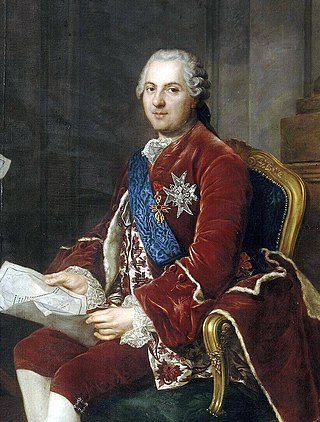
Louis, Dauphin of France was the elder and only surviving son of King Louis XV of France and his wife, Queen Marie Leszczyńska. As a son of the king, Louis was a fils de France. As heir apparent, he became Dauphin of France. Although he died before ascending to the throne himself, all three of his sons who made it to adulthood were to later rule France: Louis XVI, Louis XVIII and Charles X (1824–1830).

The Crown of Charlemagne was a name given to the ancient coronation crown of Kings of the Franks, and later Kings of France after 1237.

The Crown of Napoleon was a coronation crown manufactured for Napoleon I and used in his coronation as Emperor of the French on December 2, 1804. Napoleon called this crown the "Crown of Charlemagne", which was the name of the ancient royal coronation crown of France that had been destroyed during the French Revolution. This name allowed Napoleon to compare himself to the famed mediaeval monarch Charlemagne, King of the Franks and Holy Roman Emperor.
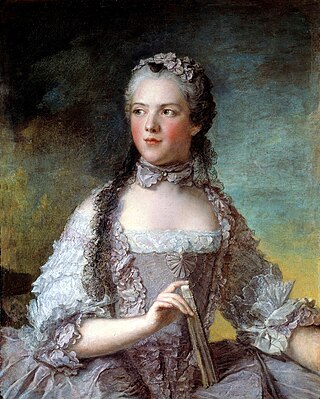
Marie Adélaïde de France was a French princess, the sixth child and fourth daughter of King Louis XV and Queen Marie Leszczyńska.

On the Day of Daggers, 28 February 1791, hundreds of nobles with concealed weapons such as daggers went to the Tuileries Palace, in Paris, to defend King Louis XVI while Marquis de Lafayette led the National Guard in Vincennes to stop a riot. A confrontation between the guards and the nobles started, as the guards thought that the nobles had come to take the King away. The nobles were finally ordered by the King to relinquish their weapons and were forcibly removed from the palace.

Marie Joséphine of Savoy was a princess of France and countess of Provence by marriage to the future King Louis XVIII of France. She was regarded by Bourbon royalist Legitimists as the titular 'queen of France' when her husband assumed the title of king in 1795 upon the death of his nephew, the titular King Louis XVII of France, until her death. She was never practically queen, as she died before her husband actually became king in 1814.
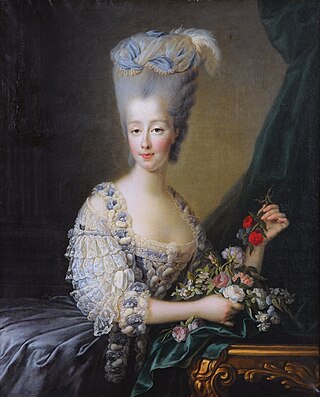
Maria Theresa of Savoy was a French princess by marriage to Charles Philippe, Count of Artois. Her husband was the grandson of Louis XV and younger brother of Louis XVI. Nineteen years after Maria Theresa’s death, her spouse assumed the throne of France as King Charles X. Her son Louis Antoine, Duke of Angoulême, married Marie Antoinette’s daughter Marie-Thérèse Charlotte.

The accession of the King of France to the royal throne was legitimized by a ceremony performed with the Crown of Charlemagne at the Reims Cathedral. In late medieval and early modern times, the new king did not need to be anointed in order to be recognized as French monarch but ascended upon the previous monarch's death with the proclamation "Le Roi est mort, vive le Roi!"

The scepter of Charles V, also known in the early modern period as scepter of Charlemagne, is one of the most prominent preserved regalia of the Kingdom of France. It was donated by Charles V to the abbey of Saint-Denis on 7 May 1380, shortly before his death. It has been used since for the coronation (sacre) of nearly all monarchs of France until Charles X, only excepting Charles VII and Henri IV. It has been kept at the Louvre since 5 December 1793.

The Coronation of Charles X took place in Reims on 29 May 1825 when Charles X was crowned as King of France, marking the last coronation of a French monarch. It took place at Reims Cathedral in Champagne, the traditional site of the coronation of French sovereigns. It was the only coronation to take place following the 1815 defeat of Napoleon and the Bourbon Restoration before the direct line were deposed in 1830.

